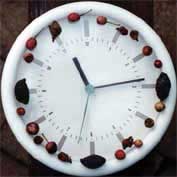
 Links
Links
New Zealand fruiting and flowering plants
There are about 1896 native species in the New Zealand flora that produce seeds of some sort. New Zealand boast 20 Gymnosperms (like kauri and kahikatea), and the Angiosperms have 552 monocotyledonous species (like grasses and orchids) and 1324 dicotyledonous species.(1)
Phenology is the study of the timing of
fruiting, flowering and bud-break in plants (although I have seen a lot of
invertebrate references have also adopted the term).
A whole range of natural cycles are triggered
or controlled by these events; such as breeding initiation in kakapo and kereru,
major changes in mouse, rat and stoat densities, and successful establishment of
translocated animal species at new sites.
It
is hoped that some of the fluctuations can be predicted by making correlations
with weather. We already know that Chionochloa
(tussock) and Nothofagus (beech) species are more or less in synchrony
throughout NZ and are most likely to have heavy seed crops one year after a warm
summer. Chionochloa
responding mainly to January or Jan-Feb temperatures and Nothofagus to
Jan-Mar or Jan-Apr temperatures. Critical
floral induction thresholds vary between sites.
Rimu is out of step with the Chionachloa-Nothofagus group. It seeds heavily two years after a cool summer, especially if
the summer just before seedfall is warm. Matai,
miro and totara seem to be broadly in step with rimu, but kahikatea is out of
step with rimu(2)
I
know from personal experience that tawa masts about every 6 years but we are not
sure of the triggers for that yet. Kohekohe
is affected by rain during flowering and fruit ripening by temperature.
So by monitoring phenology and climate we might be able to solve some of
these puzzles. However we need long
term data set to firm up these relationship
The
reason for setting up a phenology list (contact Astrid
Dijkgraaf at the Department of Conservation) is so that we can get a better
idea of how phenology for different species hangs together.
If we can pick up on more of these sorts of patterns and refine them we
might be able to target management better, e.g.
intensive predator control timed to be carried out just prior to mast fruiting
/seeding events will promote intensive breeding by certain species (kaka,
kereru, kakariki, etc) in order to promote nesting success.
Why waste $s doing predator control to promote nesting success when
little or no nesting is likely to occur.
These pages will hopefully begin to gather together current references and databases that deal with, or include information about the fruiting and flowering patterns of native trees. The bibliography, by no means complete, covers a range of topics beside fruiting and flowering patterns such
| Germination experiments | |
| Timing of bud break and leaf fall | |
| Fruit characteristics, including nutritional components | |
| Aspects that affect the dispersal of fruits |
Some of the references on the phenology bibliography page are duplicated on the native foods bibliography or pest species foods bibliography pages, This is unavoidable since the references often deal with several of these issues in one paper or report.
Please if you have any references, data or observation in addition to those that you found on these pages please write to Astrid van Meeuwen-Dijkgraaf.
References
(1) Wilton, A.D.; Breitwieser, I. (2000) Composition of the New Zealand seed plant flora. New Zealand Journal of Botany 38(4): 537-549. Web update: 1 September 2000. Version: Cronquist. Visit Composition of the New Zealand Seed Plant Flora
(2) Lee, W. G., Dijkgraaf, A. C. and Kelly, D. (1997). "Monitoring key food species of kakapo and predicting mast seed years." Landcare Research, Dunedin, Contract Research Report, LC9798/028.



